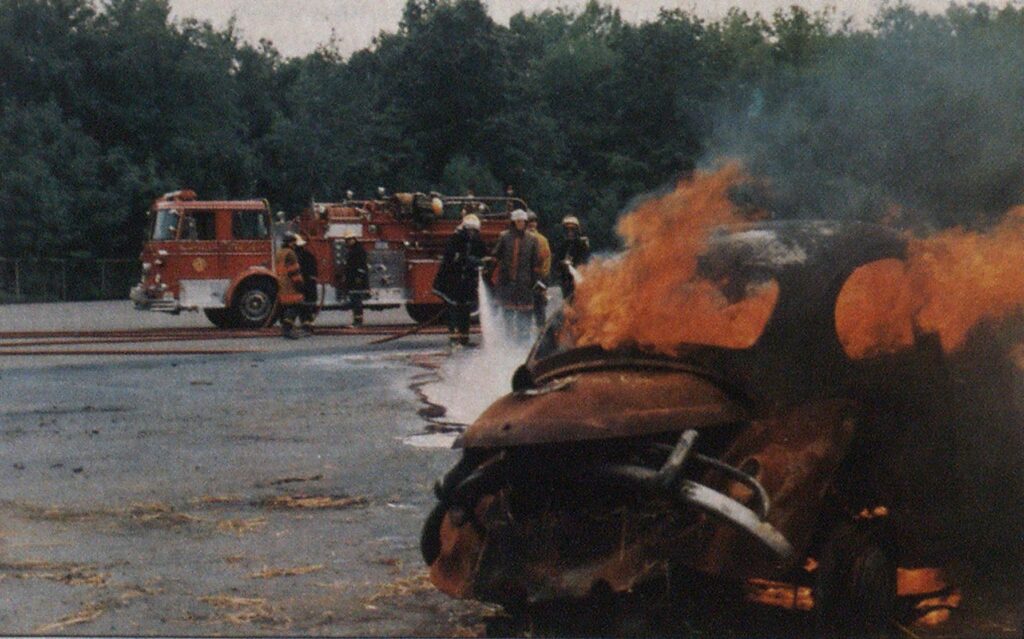
Video Technology: New Training For Automobile Fires
DEPARTMENTS
Training Notebook
The Bergen County Department of Public Safety Education, located at the Police and Fire Academy in Mahwah, NJ, has taken the giant step of incorporating video technology into its firefighter training procedures. One area where videotape can enhance classroom lectures is automobile firefighting practices.
With its dense population, Bergen experiences many vehicle fires. Lectures and hands-on exercises may not be adequate training to combat this type of fire.
Some firefighters, like most human beings, become creatures of habit and tend to underestimate the potential danger at many fire incidents. This is probably due to the frequency of false alarms, good-intent calls, smoke scares, food-on-the-stove accidents, out-on-arrival incidents, etc. Repeated responses to “nuisance” calls can dull a firefighter’s alertness. Consequently, when a “worker” does occur, safe practices are sometimes overshadowed by an eagerness to get into action.
Firefighters often become lax in following safety procedures at automobile fires that occur in relatively open locations. Because most of these incidents are generally minor, with very little fire and not too much damage, firefighters may not consider the perilous aspects present. This can lead to personnel and apparatus being positioned much too close to a medium or heavy fire condition involving an automobile.
Other concerns are the careless use of undersized hoselines and, perhaps, little or no attention given to wind direction or exposures. If firefighters have not experienced severe conditions at previous automobile fire incidents, such actions may be understandable, but they certainly are not recommended.
The hazards that present themselves at heavily involved automobile fires are sometimes more severe than those encountered at dwelling fires. Both generate heat and toxic smoke that should be properly dealt with, but an automobile contains many items that can and do explode violently.
Of primary concern is the fuel tank. Other explosive items include: storage batteries, A/C systems and hydraulic fluid systems that make up the automatic transmission, brake systems, bumper shocks, and air suspension. Even sealed, tubular steel driveshafts have exploded, as have inflated tires. Should fuel or other combustible liquids be released, a running spill fire may occur. Also, it is not uncommon to find portable fuel containers of gasoline, and even propane, present in some vehicles.
This assessment of potential automobile fire hazards demands that carefully thought-out procedures be employed, particularly when appreciable fire is present on arrival.

Photo courtesy of Bergen County, NJ. Dept. of Public Safety & Education
To better illustrate these hazards, and the most effective methods of handling them, our department has produced a 25-minute videotape on automobile firefighting. The tape shows a reenactment of firefighters responding to an automobile fire. The incident results in disaster when the fuel tank explodes, causing two of the firefighters to be severely burned.
There is an interview with these two firefighters and with the attending physician. Actual footage of the location and physical conditions existing the day of the disaster enhances these interviews. Lasting impressions of burned clothes, numerous skin grafts, and emotional trauma emphasize the need to be prepared for the unexpected, even with what may seem to be a “piece of cake” small car fire.
The last part of the program presents a safe and effective approach for fighting automobile fires. This is an actual evolution that emphasizes cooling the fire from long-range before approaching the vehicle. Training is viewed as preparation for success and lack of training as a means to injury and even death.
Bill MacDonald, video production supervisor at the Bergen County Police and Fire Academy, explains the project’s development: “When I was first approached with this project, the idea was to develop a 10-minute videotape that showed one way of safely combatting a vehicle fire. However, once the production got underway, we began to think of additional material that could also be incorporated into the tape. Hopefully, this would help firefighters to fully appreciate the potential hazards of vehicle fires.”
According to MacDonald, “The reenactment scene, which runs approximately 11 seconds, was the most difficult to shoot. Special effects were used to simulate the fuel tank explosion while one fireman, who was wearing a proximity suit under his turnout gear, was set on fire.
“The rehearsing, testing the heat temperature of the turnout gear, timing of the explosion, and other details required more than 18 hours of preparation. The end result, however, was worth the investment as we were able to achieve an extremely realistic scene. The fuel tank explosion and its aftermath visually entices the viewer to listen with interest to the remainder of the program.”
For further information on this videotape, contact: The Department of Public Safety Education, Police and Fire Academy, 281 Campgaw Road, Mahwah, NJ 07430.

